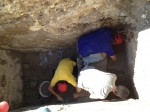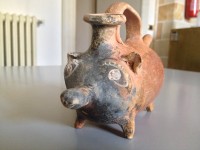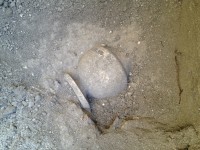 Seventeen hundred years or so before the Majapahit Empire made the first piggy banks, the Messapii people in the heel of Italy were making baby bottles shaped like pigs. An excavation this May in Manduria, a town about 20 miles east of Taranto in the region of Puglia, unearthed a cut rock tomb painted with ocher, red and blue bands dating to around 4th century B.C. Inside the eight by four-foot tomb were the remains of two adults and approximately 30 funerary artifacts including an iron knife blade, pottery plates, vases, statuettes and three gutti, vessels with narrow necks and small openings from which liquids could be poured slowly, even in drops.
Seventeen hundred years or so before the Majapahit Empire made the first piggy banks, the Messapii people in the heel of Italy were making baby bottles shaped like pigs. An excavation this May in Manduria, a town about 20 miles east of Taranto in the region of Puglia, unearthed a cut rock tomb painted with ocher, red and blue bands dating to around 4th century B.C. Inside the eight by four-foot tomb were the remains of two adults and approximately 30 funerary artifacts including an iron knife blade, pottery plates, vases, statuettes and three gutti, vessels with narrow necks and small openings from which liquids could be poured slowly, even in drops.
 Gutti were used for pouring libations in sacrifices, to oil up bodies before scraping with a strigil and as baby bottles. Two of them were fairly plain, as is customary with gutti, but the third was shaped like an adorable piggy. Discovered completely intact, the piggy guttus has pointy ears and painted on human-like eyes with long, sweet eyelashes outlined in white. The elongated, slender snout is pierced at the end. That’s what the baby nursed from. It served another function too. Inside the pig’s body are small pieces of terracotta that made the pig a rattle once all the milk was finished. Feed the baby, then rattle him to sleep. It’s a clever combination and an extremely rare one.
Gutti were used for pouring libations in sacrifices, to oil up bodies before scraping with a strigil and as baby bottles. Two of them were fairly plain, as is customary with gutti, but the third was shaped like an adorable piggy. Discovered completely intact, the piggy guttus has pointy ears and painted on human-like eyes with long, sweet eyelashes outlined in white. The elongated, slender snout is pierced at the end. That’s what the baby nursed from. It served another function too. Inside the pig’s body are small pieces of terracotta that made the pig a rattle once all the milk was finished. Feed the baby, then rattle him to sleep. It’s a clever combination and an extremely rare one.
 Despite the presence of two baby bottles, one baby bottle/rattle and two female figurines characteristic of burials of young girls in Messapii graves, no infant remains were found. It’s possible that one of the adults was pregnant when she died and was poignantly buried with the artifacts she’d accumulated in expectation. It’s also possible that an infant was buried there but her delicate bones have disintegrated over time. The tomb is almost certainly familial, in keeping with Messapian custom.
Despite the presence of two baby bottles, one baby bottle/rattle and two female figurines characteristic of burials of young girls in Messapii graves, no infant remains were found. It’s possible that one of the adults was pregnant when she died and was poignantly buried with the artifacts she’d accumulated in expectation. It’s also possible that an infant was buried there but her delicate bones have disintegrated over time. The tomb is almost certainly familial, in keeping with Messapian custom.
Objects such as a black painted basin and an iron blade of a knife suggest a male burial, while a strong clue for a female burial came from a special Messapian pottery vase called trozzella. Featuring four little wheels at the tops of its handle, versions of the vase are often found in the graves of Messapian women.
“Analysis of the funerary objects and their context suggest that the two burials followed one another in the Hellenistic period, between the end of the fourth and the third-second centuries B.C.,” Alessio said.
This is the second largest Messapian tomb found in Manduria, which is notable because the town was an important city in the Messapii dodecapolis, a confederation of 12 cities which, while ruled by their own individual kings, came together for self-defense or in case of other need. The need arose pretty frequently, thanks to their frequent battles with, among others, the Greek colonists of Tarentum (now Taranto), although they had cordial trading relationships with other cities of Magna Grecia. Messapian fighters were renown for their cavalry and archery. Archidamus III, King of Sparta from 360 B.C. to 338 B.C., felt Messapian strength most keenly when he died at the walls of Manduria while aiding Tarentum in its war against several local Italic tribes.
The Messapii were conquered by Rome in 280 B.C. Their Indo-European language died out and was replaced by Latin and Greek. Inscriptions have survived but the language is still not fully translated.
Oh, GORGEOUS!
Right? I love him so.
This is truly a very interesting item. I wonder if piggy’s pointy nose was also used as an early baby soother (pacifier, dummy). It seems to be sculptured quite unusually, but it might be just my imagination.
I think it may be a little too wide in diameter and perhaps too hard a material to serve that function, but I really don’t know. It would be cool if it was a triple function baby soothing machine, though. 🙂
I should just point people to this post when they ask why I study and love history so much (even though this isn’t my area). I would absolutely buy a replica of it.
:giggle: :giggle: :giggle:
:boogie: :boogie: :boogie:
Very cute….. but with a handle on top it seems more likely to be a pouring vessel than a suckling vessel, anyone who has ever fed a baby with a bottle would realise that’s a very impractical design, the handle would be totally superfluous. I wonder if it might have been for feeding small animals such as baby goats or lambs, the handle on top would make more sense.
Phantastic Puglia Pouring Porcelain Porcellino: I) Keep olive oil stored away from light under all circumstances. II) Keep ‘gutus’ spelled with one t and ‘gutta’ with two of them, at least if I am not totally wrong here. It seems as if ‘gutus’ (pouring jar) + ‘gutta’ (drop) = ‘guttus’, which seems to be indeed the archaeologically correct term (probably a dialect). P.S.: Romani eunt domum !!!
I agree with Ambroseus and think it could have been used as a baby bottle but maybe to feed the animal. Also, I think it could have been used as a toddler’s drinking cup. Whatever its purpose was it is just too cute.
:hattip:
Take that Milanese!
This is first time for me to send a message.
I am a Japanese.
I am intend to wright a short history about
baby bottle of Japan and world.
I red this article and my interest was awakened.
I hope using the photograph of a baby bottle shaped like a pig in my little pubrication.
Prease teach me how to do to get the photograph.